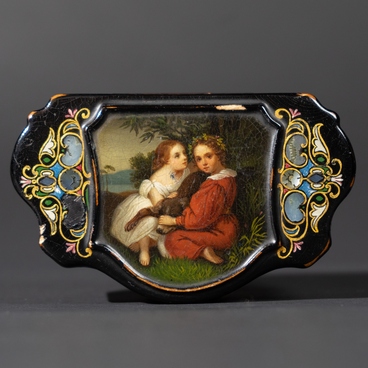In the 19th century, souvenirs with views of Moscow and Saint Petersburg depicted on them were immensely popular. In Russia, this interest arose due to a general fascination with Russian history: the first books from the multi-volume ‘History of the Russian State’ by Nikolay Karamzin were published in the late 1810s, and the Russian Historical Society was established in 1866.
Customers were especially fascinated with boxes, tea caddies and various chests made by the factory of Peter and Alexander Lukutin: their products were distinguished by a modern choice of compositions and high quality of execution. The factory’s masters gladly painted miniatures with views of Moscow, Saint Petersburg and other cities of the Russian Empire. They took European and Russian prints and paintings as a model.
It is important to note that the artists did not simply copy the originals one-to-one: they changed the composition and background, removed or added some details. Thus, the miniatures were artworks in their own right.
The tea caddy “Saint Basil”s Cathedral” was created in the 1840s-1860s, the heyday of the Lukutin lacquer miniature. It is distinguished by a light color scheme and a special delicacy of the composition, which is not overburdened with details. To the right of the cathedral, the master depicted a part of the Kremlin wall with towers, to the left — merchant stalls. The artist supplemented the architectural landscape with figures of revelers and merchants: such secondary characters, which are needed only to make the composition livelier, are called “staffage figures”.
The Cathedral of the Intercession of the Most Holy Theotokos, which is commonly known as “Saint Basil”s Cathedral’, was one of the most recognizable Moscow compositions. Ivan the Terrible ordered to build this votive church (a church erected to commemorate a specific historical event) in honor of the victory over the Khanate of Kazan.
The first mention of the cathedral dates back to the fall of 1554. It is believed that it was a wooden temple that stood for six months. In 1555-1561, a stone building appeared in its place — it has been preserved to this day. In 1588, one of the most revered Moscow fools for Christ — Basil the Blessed — was canonized (recognized as saint). A church, built over his burial, was added to the cathedral and gave name to the whole architectural complex.
Customers were especially fascinated with boxes, tea caddies and various chests made by the factory of Peter and Alexander Lukutin: their products were distinguished by a modern choice of compositions and high quality of execution. The factory’s masters gladly painted miniatures with views of Moscow, Saint Petersburg and other cities of the Russian Empire. They took European and Russian prints and paintings as a model.
It is important to note that the artists did not simply copy the originals one-to-one: they changed the composition and background, removed or added some details. Thus, the miniatures were artworks in their own right.
The tea caddy “Saint Basil”s Cathedral” was created in the 1840s-1860s, the heyday of the Lukutin lacquer miniature. It is distinguished by a light color scheme and a special delicacy of the composition, which is not overburdened with details. To the right of the cathedral, the master depicted a part of the Kremlin wall with towers, to the left — merchant stalls. The artist supplemented the architectural landscape with figures of revelers and merchants: such secondary characters, which are needed only to make the composition livelier, are called “staffage figures”.
The Cathedral of the Intercession of the Most Holy Theotokos, which is commonly known as “Saint Basil”s Cathedral’, was one of the most recognizable Moscow compositions. Ivan the Terrible ordered to build this votive church (a church erected to commemorate a specific historical event) in honor of the victory over the Khanate of Kazan.
The first mention of the cathedral dates back to the fall of 1554. It is believed that it was a wooden temple that stood for six months. In 1555-1561, a stone building appeared in its place — it has been preserved to this day. In 1588, one of the most revered Moscow fools for Christ — Basil the Blessed — was canonized (recognized as saint). A church, built over his burial, was added to the cathedral and gave name to the whole architectural complex.



